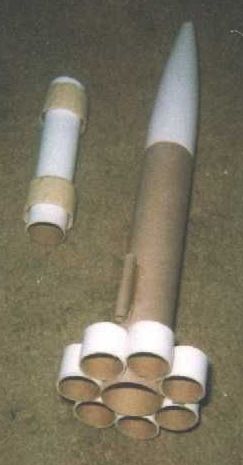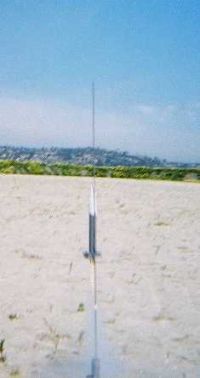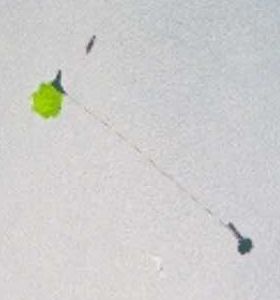Scratch Little-Big Rocket Original Design / Scratch Built
Scratch - Little-Big Rocket {Scratch}
Contributed by Larry Brand
| Manufacturer: | Scratch |

Brief:
Little-Big Rocket is a fantasy rocket design--my fantasy being that Estes and
LOC would someday collaborate on a product that could be a sort of a transitional
training rocket that could be built and flown by a father and child and using
both Estes motors and E-F Aerotech motors. Not that beefing up and overpowering
Estes kits with F-G-H motors isn't a cherished part of our hobby, but it is a
part that is not for beginners. Maybe my "product concept" doesn't
make sense or maybe that's not the way the kit business works or maybe its just
hard to do. Anyway, Little-Big Rocket is a small rocket (15 1/2", 4-5 oz)
that flies on as small as an 18mm B6-2 or as large as a 29mm AT F25-6 using
the appropriate motor adapters. It took a fair amount of thinking to get this
right. It is a very sturdy tubefin design with 7 tube fins instead of the usual
6 that I use and is fabricated from a mix of Estes and LOC components. It's
tough and flies incredibly well with more than 30 flights on it to date. Its
one of the most enjoyable rockets I've built thus far and was very fast and
cheap to scratch build. I actually thought about kitting it myself, but maybe
another time.
Construction:
Little-Big Rocket is a 29mm design that can also be flown on 24mm and 18mm
motors by using adapters. The body tube is 9" of Estes BT-60 tubing, while
the 5.5" motor tube and the 1" long high aspect-ratio tube fins are
cut from heavy-wall LOC 29mm motor tubing. A 6.75" Estes NC60 nose cone
and 1/4" LOC launch lug round out the component list. Recovery system is
7' of para cord and a 12" Top-Flite nylon chute. Note that there are no
centering rings (see below for the explanation).
Construction is amazingly simple, perfect for a first time scratch builder.
- The 9" long BT-60 body tube, 5.5" long 29mm motor tube, and seven 1" x 29mm tube fins are cut from the appropriate stock with a razor saw.
- Using 5-minute epoxy, attach the tube fins flush with the bottom of the motor tube one at a time, using a flat surface as a jig. When you get to the last one, there will be a space slighty larger than the 29mm tube fin--just add some thin balsa or cardstock spacers on either side to insure a good fit. The rocket doesn't know the difference and once painted neither will anybody else.
- Now for the motor tube installation "trick". The centering "rings" are made of wraps of 5/8" masking tape wound around the motor tube 1/2" from both ends until the motor tube fits snuggly into the BT-60 body tube. Then, slather lots of 5-minute epoxy onto, above, and below each ring and insert into the body tube so that about 3/8" protrudes from the bottom. Roll it around in your hands a few times while the epoxy sets so it distributes evenly. This forms a very solid motor mount installation.
- The 7' of para shock cord is anchored through a hole poked through the body tube 1.5" from the top with the knot covered by half of a plastic cigar tube. The 2" long piece of 1/4" LOC launch lug is epoxied to body tube centered 1.5" above the fin can and inline with center of a tubefin. The lug was epoxied onto a piece of popcicle stick stand off so it clears the tube fin.
- About the adapters: these can be purchased, but I cut my own from a spent 29mm single use AT casing for 24mm motors and a plastic Garcia-Vega cigar tube for 18mm.


Finishing:
I used Testors navy grey to finish the rocket.
Flight:
Little-Big Rocket flies in two configurations: one for 18mm and 24mm and one
for 24mm and 29mm. For the former, the 24mm-to-29mm adapter is left permanently
in place. The reason for the two configurations is the need for 32 grams (about
1 1/8 oz) of sand ballast in the nose cone if 29mm motors are selected. No
ballast is needed for the recommended 24mm motors.
The recommended motors (I have flown them all) are for the 24mm-29mm configuration: C11-3, D12-5, AT E30-7, AT F21-4, AT F20-4, F23-4 and F25-4/6. The recommended motors for the unballasted 18mm-24mm configuration are: B6-2, C6-5, C11-3, D12-5, E30-4, Ellis Mountain E12-4, and AT F21-4. The Estes E9-4 works in the ballasted version ONLY and only in light winds. Maximum performance was on an F25-6, for which sims (using Cd=1.5) predicted an apogee of 1750'. Both times that I flew F25s in Little-Big Rocket, it shot out of sight and I had to rely on sharp eyed flying buddies to track it or I would have lost it for sure. Ideal motors for "dad" are the F21-4, F23-4 and F20-4 predicted to give about 1200' boosts, which is about what I observed. The new Ellis Mountain E12-4 is just the perfect motor for this rocket with about 900-1000' for a nice, straight launch. The 150-250' boosts from B-C motors are perfect for unassisted launches by a younger flying buddy.


Recovery:
The 12" chute was perfect for all motors, although in hindsight, a
15" chute would be better for the heavier 29mm motors. As with all
tubefins, Little-Big Rocket excels in wind, with little weathercocking.
Summary:
PRO: an extremely versatile rocket, flies on B through F motors. As easy and
cheap to build as you'll find anywhere. Decent performance for its size but
without going into the next county. A perfect scratch project for a father and
son.
CON: Hard to see at 1700' when boosting on an F25!
Sponsored Ads
 |
 |











